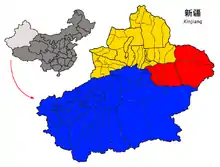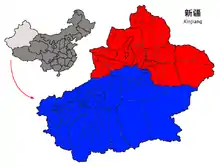Southern Xinjiang
Southern Xinjiang or Nanjiang (Chinese: 南疆; pinyin: Nánjiāng) is the southern half of the Xinjiang Uyghur Autonomous Region of China. Its historical name was Altishahr (Chinese: 回部; pinyin: Huíbù), which also includes some territories in modern-day Afghanistan, Kyrgyzstan, and Tajikistan. The name "Chinese Turkestan" was commonly used by Europeans to refer to Southern Xinjiang or Xinjiang as a whole[1] especially during the Qing dynasty.

Northern Xinjiang – Dzungaria (yellow), Eastern Xinjiang – (Turpan and Hami) (red), and Southern Xinjiang – Tarim Basin (blue)

Southern Xinjiang includes the Tarim Basin and the adjacent mountainous area which includes Aksai Chin. Most of the inhabitants in Southern Xinjiang are Uyghurs.
See also
References
- "The Great Game Revisited: Three Empires Collide in Chinese Turkestan (Xinjiang)". JSTOR. Retrieved September 19, 2023.
This article is issued from Wikipedia. The text is licensed under Creative Commons - Attribution - Sharealike. Additional terms may apply for the media files.